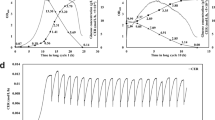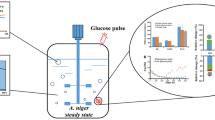Conclusions
Except for the pronounced adaptation-hysteresis effect, the pulse experiments exhibited the expected trend: deviation from the steady feed reference curve was greatest at lowest dilution rates. Under conditions of lowest glucose level the effect of pulsing would be expected to cause the largest fluctuations in glucose, causing a certain fraction of the cells to ferment. Generally over the entire dilution rate range the biomass production was decreased and the ethanol was increased by pulsing the feed stream. There is, however, some evidence that pulse feeding can trigger quite unexpected results. Point (6) at D=0.3 h−1 in Fig. 1 exhibit a biomass productivity which was about 20% greater than the continuous feeding reference value (DX=3.6 kg m−3 h−1 as compared with 3.0 kg m−3 h−1). Such performance would be of significant commercial value, but the poor reproducibility due to adaptation, as seen here, certainly would preclude its application.
The results obtained should also be applicable to fed batch operation at the corresponding glucose level. Further experiments including the variation of the glucose feeding period would be necessary to obtain a conclusive picture. The observed phenomena are likely to occur in other fermentations and could eventually explain some of the problems existing with scale up of fermentation processes.
Similar content being viewed by others
Abbreviations
- D:
-
dilution rate h−1
- P:
-
product (ethanol) concentration kg m−3
- QO2 :
-
specific oxygen uptake rate mol kg−1 s−1
- QCO2 :
-
specific CO2 production rate mol kg−1 s−1
- S:
-
substrate (glucose) concentration kg m−3
- X:
-
biomass concentration kg m−3
- YP/S :
-
yield of ethanol from glucose kg kg−1
- YX/S :
-
yield of biomass from glucose kg kg−1
Literature
Bailey, J. (1978). Periodic Phenomena. In “Chemical Reactor Theory”, L. Lapidus and N.R. Amundson, eds., pp. 758, Prentice-Hall, Englewood Cliffs, N.J.
Baldyga,J. and Bourne,J.R. 1984). Chem. Eng. Commun.28, 259.
Brooks,J.D. and Meers,J.L.(1973). J. Gen. Microbiol.77, 513.
Furukawa,K., Heinzle,E. and Dunn,I.J.(1983). Biotechnol. Bioeng.25, 2293.
Heinzle,E., Nishizawa,Y. and Dunn,I.J.(1981). Ann. N. Y. Acad. Sci.369, 159.
Heinzle,E., Dunn,I.J., Furukawa,K. and Tanner,R.D.(1983).Modelling of Sustained Oscillations Observed in Continuous Culture of Sacchoromyces cerevisiae. In “Modelling and Control of Biotechnical Processes”, Proc. of the First IFAC Workshop, A.Halme, ed., pp.57, Pergamon Press, Oxford.
Knoepfel,H.P., Diss. ETH Zuerich, No.4906 (1972).
Meyenburg,K. von. (1969). Diss. ETH Zuerich, No. 4279 (1969).
Moes,J., Griot,M., Keller,J., Heinzle,E. and Dunn,I.J. (1985). Biotechnol. Bioeng., in press.
Oosterhuis,N.M.G.(1984). “Scale-up of Bioreactors”, Diss., Techn. Univ. Delft.
Prigogine,I.(1980). “From Being to Becoming”, Freeman, San Francisco.
Spruytenburg,R.(1977). Diss. ETH Zuerich, No.6080.
Author information
Authors and Affiliations
Rights and permissions
About this article
Cite this article
Heinzle, E., Moes, J. & Dunn, I.J. The influence of cyclic glucose feeding on a continuous bakers' yeast culture. Biotechnol Lett 7, 235–240 (1985). https://doi.org/10.1007/BF01042369
Issue Date:
DOI: https://doi.org/10.1007/BF01042369




